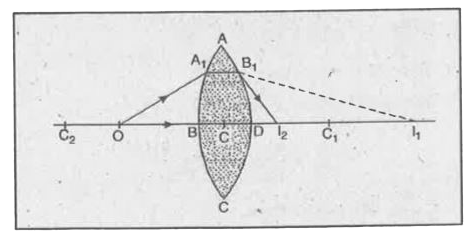Derive lens maker's formula for a thin biconvex lens.
Text Solution
Lens maker.s formula for biconvex lens
Sign Conventions
1. All the distances are measured from the optical centre of lens.
2. Distance measured in the direction of incident light is + ve.
3. Distance measured in the direction opposite to the direction of incident light is negative.
Assumptions
1. Object is a point object.
2. Lens is thin so that distances are measured fromthe poles of its surfaces.
3. The aperture of the lens is small.
4. Angles of incidence and refraction are small.
Let and be centres of curvature of two spherical surfaces ABC and ADC with optical centre C. Let be the refractive index of the material of the lens and that of the medium surrounding the lens where .
Consider a point object O lying on the principal axis of the lens.
Refraction at the surface ABC. A ray of light starting from O strikes the surface ABC at with is a normal. On refraction it bends towards the normal and proceeds along . Another ray OB starting from O and incident at B, passes through optical centre C. If the lens material were continuous, the two refracted rays would actually meet at . Thus , would be the real image of the point object.

Applying spherical equation for surface ABC
...(1)
This image , acts as an object for spherical interface ADC and thus final image is formed. is the effective position of the image corresponding to the lens ABCD as a whole.
For surface ADC,
But ( lens is thin)
...(2)
Adding (1) and (2), we get
If O is at infinity [i.e. ] the image will be formed at principal focus, [i.e. ]
...(3)
Applying new cartesian sign conventions, we get
and
So Eq. (3) becomes
or
or
where , and is called relative refractive index of lens w.r.t. surroundings.
|
Topper's Solved these Questions
- OPTICSBOOK - MBD -HARYANA BOARDCHAPTER - OPTICSEXERCISE - OBJECTIVE TYPE QUESTIONS
26 Videos
- OPTICSBOOK - MBD -HARYANA BOARDCHAPTER - OPTICSEXERCISE - SHORT ANSWER TYPE QUESTIONS
46 Videos
- MODEL TEST PAPER - 2BOOK - MBD -HARYANA BOARDCHAPTER - MODEL TEST PAPER - 2EXERCISE - SET - D ( LONG ANSWER TYPE QUESTIONS)
4 Videos
- PRINCIPLES OF COMMUNICATIONBOOK - MBD -HARYANA BOARDCHAPTER - PRINCIPLES OF COMMUNICATIONEXERCISE - Objective Type Questions
19 Videos
Similar Questions
Knowledge Check
Lens maker's formula is applicable to
AThin lenses and paraxial rays which subtend very small angles with the principal axisBThick lenses and paraxial rays which subtend very small angels with the principles axisCThin lenses and for marginal raysDThick lenses and for marginal raysThe lens maker's equation is given by
A1f=(μ1μ2−1)(1R1+1R2)B1f=(μ2μ1−1)(1R1+1R2)C1f=(μ2μ1−1)(1R1−1R2)D1f=(μ1μ2−1)(1R1−1R2)
(a) Derive lens maker's formula for a biconvex lens. (b) A point object is placed at a distance of 12 cm on the principal axis of a convex lens of focal length 10 cm. A convex mirror is placed coaxially on the other side of the lens at a distance of 10 cm. If the final image coincides with the object, sketch the ray diagram and find the focal length of the convex mirror.
View SolutionDerive lens formula for a concave lens.
View SolutionUsing lens maker's formula, derive the thin less formula 1f=1v−1u for a biconevex lens.
View SolutionWrite the basic assumptions used in the derivation of lens- maker's formula and hence derive this expression.
View SolutionLens makers Formula||Magnifications
View SolutionDerive lens maker's formula for a thin convex lens.
View Solution
